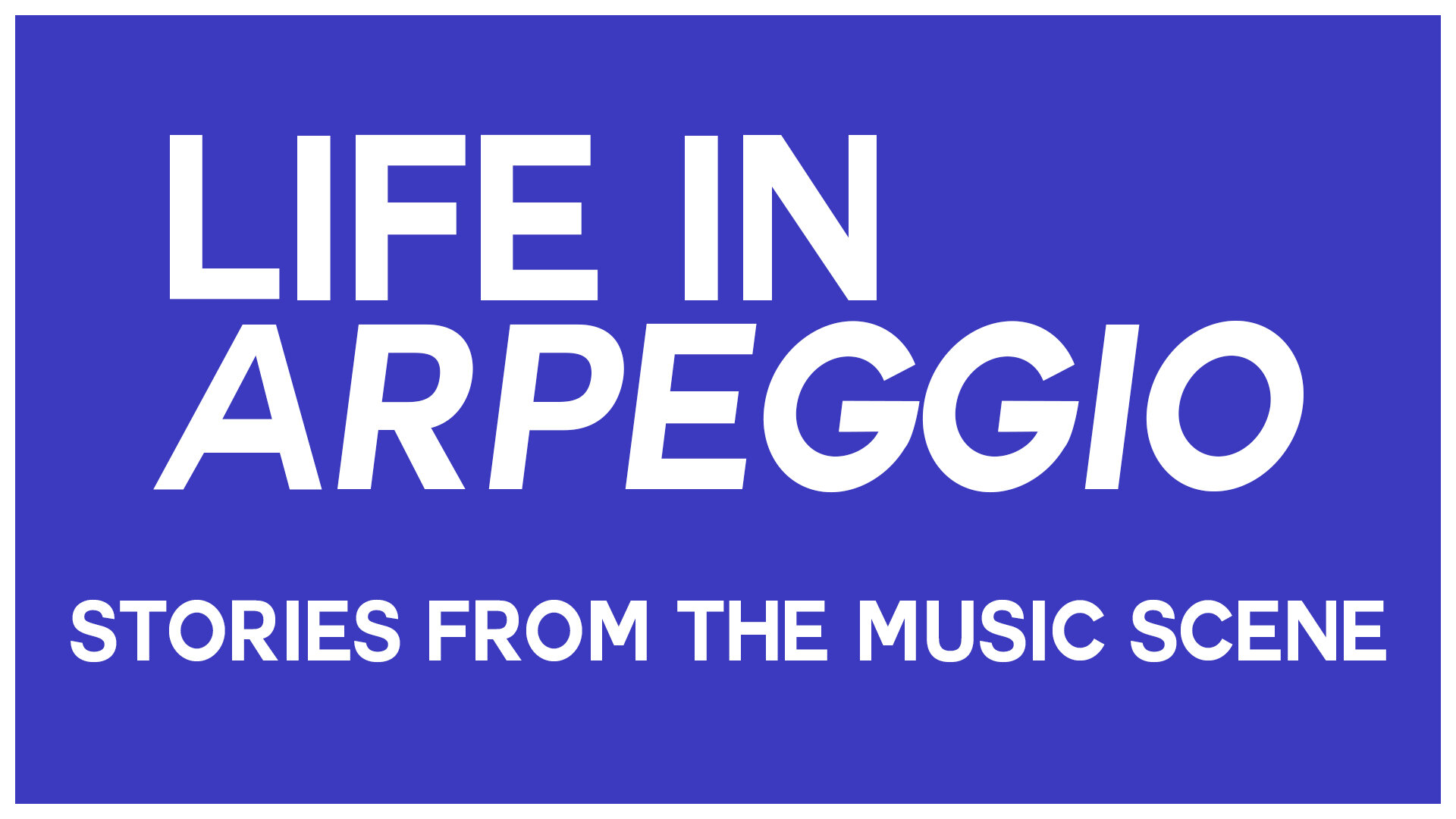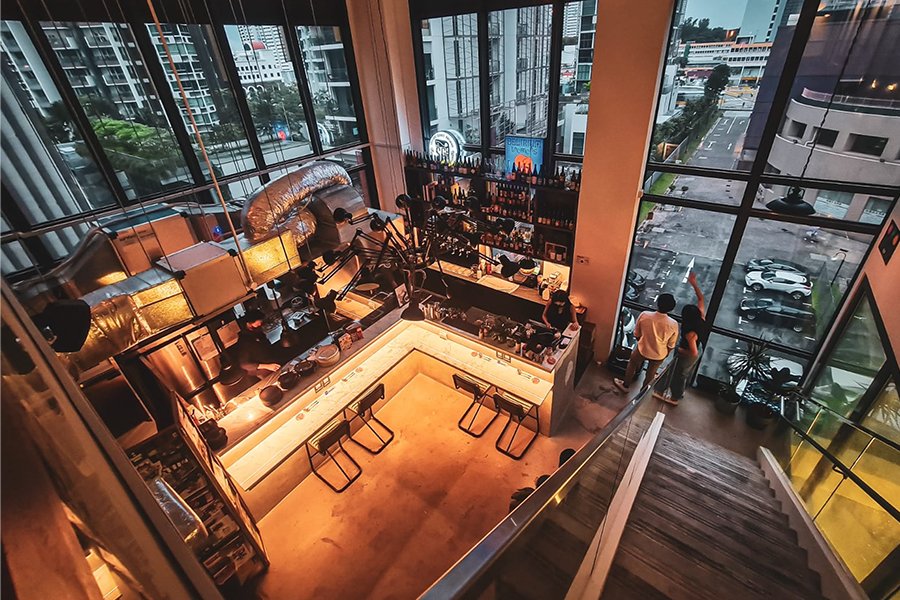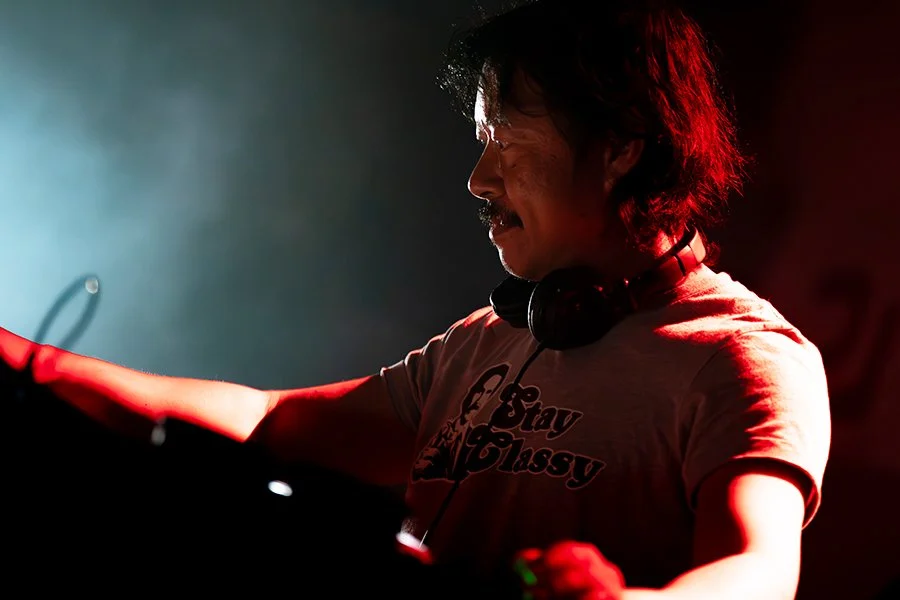Crossing Cultures: SAtheCollective On Fusing Classical Chinese Music With Electronica
The SA identity has evolved into a full, artistic collective in the last decade (Credit: Courtesy of SAtheCollective)
When pursuing the future, you don’t need to neglect your past. Applying this maxim in their music is SAtheCollective, that’s combined the contemporary nature of electronica with their background in classical Chinese music. Though experimental techniques, they enhance traditional instruments like the dizi and guzheng to blend with the boundless playspace of electronic composition, creating instrumental opuses that are mystical and mechanical; spiritual essences intertwined with skeletons of circuitry. It’s this duality in their sound that makes the SA identity an arbiter of radical pursuits, far beyond the tunnelled visions of most.
Conceptualised in 2011, first as a trio, the atypical outfit has since evolved into a beefier collective with several members involved in the myriad ambitions of the group. At its core, the musical ensemble currently consists of four creative minds: the founding duo of Andy Chia and Natalie Alexandra, combined with Govin Tan and Vick Low with similar portfolios in ethnic music. As the collective’s Artistic Director, Andy is heavily involved in fusing his musical expertise with the arts, culminating in sound installations and culture-crossing series like ETHNI-CITY. Meanwhile, Natalie is the founder of LittleCr3atures by SA, an initiative that exposes young children to diversities in sound, exploring an untapped way of communication and expression. SA is the house that safeguards these several projects, sharing the same creative lifeblood that flows in their musicality.
Samsara is the collective’s latest full-length released in the coda of 2020, a nine-track odyssey of criss-crossing textures and unyielding exploration. Spanning percussive cacophonies, pensive drones, iridescent climaxes and even a capella beatboxing, the album of world music forms its own narrative that beckons interpretation. The heart of the record was inspired by the Sanskrit depiction of karma, and how the balance between life and death can be applied to the context of Singapore’s aggressive development – are we headed towards utopia or dystopia? It’s themes like these that drive the direction of SAtheCollective, and it makes them more than just one of the scene’s most cogent storytellers, but activists in music.
From their evolution through the years to the tropes and motifs that influence their sound, Andy and Natalie share the stories that’ve nurtured their SA identity in this interview.
Co-founders Natalie Alexandra and Andy Chia (Credit: Margherita Caprilli)
Hi Natalie and Andy. I’m really glad that you guys have remained active in the scene since I came across your music years ago (2013, I believe!). From a trio to a full-scale collective, how would you sum up the evolution of the SA brand over time?
Hi Kevin! Really happy that we’re still in touch after all these years, to silently support and mature together as artists and creatives in our own realms. We began as a trio in 2011 or so, and always had the vision of expanding into a collective, as we felt that a healthy ecosystem was necessary within a group to fulfil our artistic vision where we were interested in creating shows apart from playing at regular music gigs.
This became increasingly concrete as we embarked on applications and received the SEED Grant in 2016 and Major Grant in 2019; the grants were organisational development grants, entailing the need for us to build both an infrastructure to ‘house’ our system. Having such an infrastructure allowed us to be in a position where we could offer collaborations to others with SA, fulfilling not only our cross-ethnic and cross-cultural but also our cross-disciplinary vision. This is important to us as we firmly believe that the arts is a whole that resonates with our beings as humans, and is also crucial to our relationship with Nature.
“While our training in Chinese classical music is strong, and was absolutely foundational to who we are as musicians today, we don’t necessarily think like a classical musician.” (Credit: Courtesy of SAtheCollective)
With your respective backgrounds with Chinese instruments, was it a natural extension of yourselves when you first decided to incorporate these sounds into electronica? And when you do, do you still think like a classical musician?
Actually, it may have been the other way round. We did grow up playing Chinese music and instruments in orchestral and solo settings. As we delved deeper into the criticality of what ‘Chinese music’ or the ‘Chinese’ identity was for us as Singaporeans, we began to realise that what we know commonly as the ‘Chinese Orchestra’ was a post-cultural revolution, post-1960s construct. As we continuously sought an identity for ourselves as a music collective, we began to incorporate electronic sounds through the use of effects pedals, as well as other extended techniques such as beat-boxing on the Chinese flute or using the tuning wrench on the guzheng.
While our training in Chinese classical music is strong, and was absolutely foundational to who we are as musicians today, we don’t necessarily think like a classical musician. In fact, it’s hard to say how a classical musician thinks, because we have not played music in that setting for a while now. We may think more like improvisers, or experimental musicians perhaps? Where sound and performance to us is like an inquiry; where experience and awareness of mind, body and soul in aligned or misaligned manners are manifested through the multi-modal ways in which sound is perceived.
“Sounds take on different meanings, culturally or socially, at different times. Adopting contemporary electronics is only natural.” (Credit: Courtesy of SAtheCollective)
Whereas for the adoption of electronics, what is your approach like when using these newer technologies to shape your vision?
Whatever the medium – whether playing an instrument traditionally, classically or electronically – is perhaps something we no longer view in silos, but really as different tools in which sound can be manipulated; different tools in which the body interacts with sonic objects to create sounds; or different tools in which the sonic objects interact with the environment. As we built upon our classical Chinese foundation to explore different means of making music or creating sounds, the electronic medium similarly becomes a means of creating sounds. Essentially, we are responding to the contemporary times and digital/electronic environments around us. Sounds take on different meanings, culturally or socially, at different times. Adopting contemporary electronics is only natural.
SAtheCollective also consists of additional members, Govin Tan and Vick Low (Credit: Courtesy of SAtheCollective)
Can you tell us about the other musical members of the collective and what they bring to the table?
Currently, we have Govin Tan and Vick Low with us. One may know Govin from Flame of the Forest and Vick from Canvas Conversations.
Govin is a multi-percussionist. He not only has a solid foundation in the Indian tabla, but also various other percussion instruments such as the frame drum. He is also well-versed in the drum kit, and had received education in jazz drumming. He created his unique drum-percussion kit set for SA, and that’s how his personality shines through his music with us.
Vick plays the cello and used to play in Chinese Orchestras (Andy had even conducted him before!), had training in electronic music, sound designs for theatre productions, and creates in the realm of theatre for young audiences. He fuses cello with electronics and brings injured sound, with sensitivities as audio engineer and sound designer to SA’s sounds.
The sets of SA often seem unpredictable and spontaneous (Credit: Courtesy of SAtheCollective)
When you create songs together, how much of it is improvised or rehearsed beforehand? Do you always decide on a narrative before focusing on the music?
Usually, the creation is improvisational. We improvise to compose. But it depends on the nature of the project itself whether the performance is improvised or rehearsed beforehand.
For example, in a trip to Bologna, Italy in 2018, it was an entirely improvised, experimental set with no pre-decided narrative. However, for our latest album, Samsara, as well as new music we’ll be releasing along with a Singapore Chinese Cultural Centre event in June 2021, there were some key ideas that developed into a loose narrative. The loose narrative guided the trajectory of the creation. Such trajectories are important for us in deciding the ebb and flow of the music and holistic sonic experience for our listeners.
Let’s talk about your latest Samsara album. Thematically, it addresses the potentially dystopian trajectory of Singapore’s relentless development. Why did you want to touch on this issue, and why now?
Probably because we had our own kids. As children, didn’t we always wonder what we would become when we grow up? And as we became adults, we may have wondered what kind of career path we would take, or what dreams we would want to fulfil.
But as parents, having kids now makes us a family. And we wonder, what would our children’s future look like when they turn our age now? What is the world going to be like? What skills do they need to navigate through the world? And as we reflect upon these questions, we can’t help addressing the disharmony and dis-engagement we have had from Nature because of relentless development, as you say. We’ve perhaps grown economically, made lots of money, but what have we lost in that process? What have we harmed in that process? How do we make peace? How do we re-align with Nature? How do we live in harmony and be one and whole again as people?
There have been many recent events as well that reflect dystopic notions: Hong Kong’s riots (Nat’s dad is a Hong Konger); Natural disasters such as the 2018 tsunami in Indonesia; COVID (of course). Ancient wisdom suggests that when one is in harmony with Nature, one is in harmony with oneself. But where have we gone with that?
ThirdSpace is the home and creative space of SAtheCollective and LittleCr3atures (Credit: Courtesy of SAtheCollective)
Can you tell us more about your ThirdSpace studio? Is that a habitat where your artistic curiosities can truly roam free?
It’s a space that creates the conditions for artistic things to happen. ThirdSpace is really a reference to Homi Bhabha’s theory of third space, where every person as an actor or context is really a hybrid. We also interpret it as a space of liminality. And in this space of liminality are limitless possibilities.
What new techniques or experiments did you try with the construction of this album?
In Samsara, we had two drummers. Apart from Govin on the percussion kit, Anson Koh (from The Steve McQueens) was on the drum kit as well. While Govin and Vick have been long-time partners, collaborators and friends with us, it’s also the first time we have an official recording with them. Natalie also explored vocals and drums in the recording process of Samsara.
You’re also the driving force behind ETHNI-CITY which salutes the multi-cultural identity of Singapore; a sentiment that runs in the veins of SA. Do you see yourselves playing a vital role in bridging these various cultures together?
Perhaps not so much of bridging. In our multicultural works, we seek to respect, understand and build our capacities for empathy for others, in an attempt to seek some form of transculturalism where we transcend and develop a sound or culture that reflects the unique identities of who Singaporeans might be. We are a young nation with immigrant culture and perhaps our identities are not strong, like the American or Australian identities are. ETHNI-CITY is a processual project that seeks to work towards such transculturalism.
You’ll find Andy’s works beyond the musical domain (Credit: Courtesy of SAtheCollective)
Andy, you’re a multi-disciplinary artist who wears many hats. Why do you like to keep busy in domains beyond music?
Arts could and perhaps should be viewed as one and whole. As cliche as it sounds, life is art as much as art is life. I create, I sing, I move, I dance, I embody. It’s all part of life, who I am, and what I stand for. Furthermore, the experience of music is hardly limited to the domain of music itself. We move to music, as sound vibrates through us. We play an instrument through the expression of our bodies in interaction with an object. Music in itself is multi-disciplinary, as life is.
Natalie wishes to expand the imagination of young children with LittleCr3atures (Credit: Courtesy of SAtheCollective)
And Natalie, you’re the mother of LittleCr3atures, an initiative that inspires children to be creative with sounds. Why is it so important to expose young minds to the power of music and sonic creation?
We had always wanted an initiative for young audiences because our music was not necessarily friendly to most, and believed that early exposure to a diversity of sounds and music was important.
I experimented for a while, and worked as a Research Assistant while observing little children in preschool, and then decided to take it seriously by doing my doctoral research in this area.
Then, we found ourselves expecting and I really got serious into researching about why sounds are so important to a baby’s life, and found that sound is really not just about the experience of an artform, but had survivability and socio-emotional functions. It may seem obvious or even overwhelming to some that babies cry to express a need, such as hunger or tiredness. But those first cries serve the function of getting their adult counterpart (mostly the mother) to attend to them, for milk! As the baby grows and starts to ‘baby-talk’, adults tend to engage with those first conversations, don’t we? And if we’d just stop to notice, those early conversations or protoconversations are rhythmic in nature, have the qualities of melodies and even narrative structures, as the theory of communicative musicality asserts. So, the academic theories aside, sound is innate; it’s how we are as intersubjective beings. It is very much our being.
When they’re not making experimental symphonies, they’re engaging the minds of young children with the power of music (Credit: LittleCr3atures)
Apart from that, in my work with preschool children, I had also noticed how their musical play tends to be improvisational and experimental, very much like our practice as experimental musicians in SA. Kids may take to nursery rhymes and children’s songs but really, in their play, it’s the experimentation that engages them. So why not just provide opportunities for children to just be, and do it? Rather than rigid, sit-down listening or piano playing sessions that are so against or counter-intuitive to their nature as children?
For the both of you, how do you juggle between family time and SA time? Or do they often blend into each other?
It’s really not so much a juggle as much as it is a whole. We are very hands-on parents, both of us, so we prefer to keep our babies close to us. Dodo, our firstborn travelled with us to Bologna, Italy for an experimental music festival at four months old. Both Dodo and now Rhea (second born) attend all our rehearsals and meetings with us.
“It’s really time to think and reflect upon ourselves being in harmony or not with Nature and our environment.” (Credit: Courtesy of SAtheCollective)
And lastly, how have the struggles of the pandemic affected the progress of the collective?
We miss certain experiences that we had before, such as international touring and performing at festivals. However, the pandemic also got us reflecting, thinking and adapting. While the activities we had conducted may not have been what was planned or expected, we have definitely progressed in terms of being flexible and adapting to the ‘new normal’, such as creating digital works and reflecting on different modes of creation and engaging the audiences. No one likes a pandemic, but like we mentioned earlier, it’s really time to think and reflect upon ourselves being in harmony or not with Nature and our environment.
You can follow the numerous initiatives of SAtheCollective on their official website, and listen to their Samsara album on Bandcamp. Stay updated with their activities on Facebook and Instagram.



















